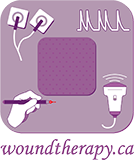ESTIM REFERENCES
Randomized Controlled clinicial trials conducted within South Western Ontario, Canada that demonstrate the Estim stimulates wound healing rates and promotes wound closure of:
- Leg and Foot Ulcers [Houghton et al, 2003 Physical Therapy 83(1):17-28]
- Pressure in people with Spinal Cord Injuries [Houghton et al., 2010 Arch Phys Med Rehabil 91:669-78.]
Houghton 2017 [Chronic Wound Care Management & Research. 4 25–44.] A recent critical review written by Dr. Houghton provides a comprehensive list of all clinical trials and systematic reviews published since 1968 about the effects Estim on healing rates of various types of wounds. Critical appraisal of existing research revealed that systematic reviews that had higher quality (per PRISMA guidelines) and included a greater proportion of available research were more likely to find Estim can improve healing outcomes of pressure injuries, diabetic foot wounds, and venous leg ulcers
Koel & Houghton, 2014 [Advances in Wound Care 3(2):118-126] The article pools data from several clinical trials to show Estim stimulates healing of chronic wounds. Sub group analysis also indicates significantly faster healing can be produced when Estim is delivered directly into the wound using currents that are uni-directional and generate an electrical charge within tissues underlying the electrode (in the wound base).
Houghton, 2014 [Advances in Wound Care.3(2):166-183.] This invited review provides an overview and analysis of the different Estim devices and protocols used to stimulate wound healing. Clinical trials involving a particular type of Estim called High Voltage Pulsed Curren t (HVPC) were not included in this review.
Polak et al., 2014 [Advances in Wound Care.3(2):160-165.] reviews controlled clinical trials that evaluated the effect of a particular type of Estim called High Voltage Pulsed Current (HVPC). HVPC has been shown to accelerate wound closure of pressure ulcers, and venous leg wounds.
Zhou et al., 2016. [Eur J Clin Invest 46(12): 1017–1023, 2016]. Show factors that predict a positive response to Estim include shorter wound duration (those that have been present for less than 6 months), when patient comply with regular Estim treatment regimens, and leg ulcers caused by venous insufficiency).
Zhou, 2017. [Ostomy Wound Management 62(3):36-44]. This case series demonstrates Estim can safely and effectively be applied in conjunction with wound dressings composed of silver & collagen.
Houghton, Nussbaum, Hoens, 2010. Electrophysical Agents: Contraindications & Precautions. [Physiotherapy Canada 62(5):13-73]. This special supplement of Physio Canada journal compiles research and provides rationale for conditions that can increase the likelihood of an adverse reaction therapeutic modalities including Estim used for wound healing.

